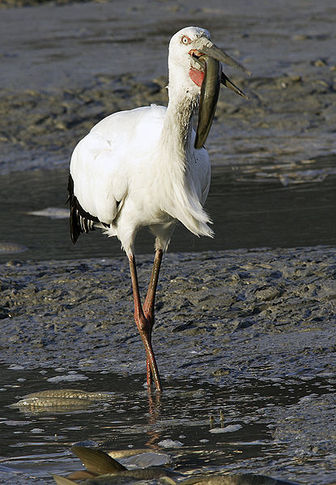Oriental white stork
At one time, the Oriental Stork could be found in Japan, China, Korea and Russia. It is now extinct in Japan and Korean peninsula. However, in May 2007 a hatchling was reported in Japan for the first time in 40 years in the wild. It was offspring of two storks who were bred in captivity. After breeding, the storks migrate to eastern China in September and return in March.

Original source: 本人撮影
Author: spaceaero2
Permission: GNU Free Documentation License
The Oriental white stork is classified as Endangered (EN), considered to be facing a very high risk of extinction in the wild.
Oriental White Storks have disappeared completely from parts of their former range on the islands of Japan and the Korean Peninsula. The bird’s nesting area in northeast China is also shrinking dramatically (slightly more than 120 pairs were reported in 2004). The bulk of the population – about 380 to 430 pairs – occupies wetlands in the southern part of the Russian Far East. More
fringed wings, Oriental White Storks used to be found across east Asia, migrating from Korea and Japan to eastern China and Russia after breeding. But from the 1950s Oriental White Storks began to disappear. In Japan, the last chick to have been successfully bred in the wild is believed to have hatched in 1964. And the bird has been considered officially extinct since the early 1970s, when the last group of wild birds were taken into captivity. More
The Oriental white stork is classified as Endangered (EN) on the IUCN Red List 2007 (1) and is listed on Appendix I of CITES (3). It is also listed on Appendix I of the Convention on Migratory Species (CMS or Bonn Convention) (4) and on Schedule I of the Indian Wildlife (Protection) Act 1972 (5). Description - This tall and elegant bird can be identified by the ruff of longer feathers across the throat and upper breast. More
The Oriental white stork breeds along the border of Russia and mainland China, particularly in the Amur River and Ussuri River basins. It winters in the lower Yangtze River basin and southern China, although small numbers are also found in North Korea, South Korea, Japan, and occasionally in the Philippines, northeastern India, Burma and Bangladesh. It may also be found as a summer vagrant in eastern Mongolia. The current population is thought to stand at 3,000 birds, following considerable declines in Russia (2). More
Oriental White StorkThe Oriental Stork, Ciconia boyciana is a large, up to 115cm long, white bird with black wing feathers. It is closely related and resembles the European White Stork, of which it was formerly often treated as a subspecies. Unlike the latter species, it has red skin around its eye, a whitish iris and black bill. Its diets consist mainly of fish, frogs and small animals. The Oriental Stork is a solitary bird except during the breeding season. More
Oriental White Stork in Jeju - October 26, 2007 Yongchang Jang (yongchangjang@hotmail.com) An Oriental White Stork ( Ciconia boyciana ) was observed in Jeju Island, South Korea again. The picture that was taken by Mr. Heeman Kang, a local news reporter, on October 25, 2007 in a deserted rice paddy in Yongsuri villiage, west Jeju, can be seen on the website of Jeju Wildlife Research Centre. (www.birdsinjeju. More
Oriental white storks in the Hyogo district of Japan, where the reintroduction of traditional farming methods is helping them thrive * Photos enlarge When Japan's last oriental white stork died in 1971 it was thought that the birds had disappeared forever. The wetlands where the stork nested had been irrigated, and development damaged its habitat. But in a remarkable success story, the storks are thriving again after a reintroduction programme. More
Oriental White Stork Conservation Involved Groups Government, non-governmental organizations, citizens, researchers, Hyogo Prefectural Oriental White Stork Homeland Project Category Protection of rare and endangered species Brief Summary Protection of the nesting sites of Oriental White Stork by construction of artificial piers, environmental education and public awareness Objective Oriental White Stork (Ciconia boyciana) is included to International Red Data Book, More
Not since 1972 has the Oriental white stork flown in Japan's skies. Today's release is the result of international co-operation, a captive breeding program and a feat of wetlands repair that has brought it back from extinction. Environmentalists in Japan say the rebirth of the stork, the first time the country has managed to revive a lost species, is a model for the future. Five birds are to be released today and another four later, leaving 100 remaining in a sanctuary. More

Original source: Ltshears
Author: Ltshears
Permission: Some rights reserved
Family : Ciconiidae
Genus : Ciconia
Species : boyciana
Authority : Swinhoe, 1873

